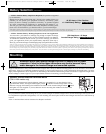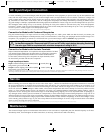
9
• Connect DC Wiring: Though your Inverter/Charger is a
high-efficiency converter of electricity, its rated output capacity is limited
by the length and gauge of the cabling running from the battery to the unit.
Use the shortest length and largest diameter cabling (maximum 2/0 gauge)
to fit your Inverter/Charger’s DC Input terminals. Shorter and heavier
gauge cabling reduces DC voltage drop and allows for maximum
transfer of current. Your Inverter/Charger is capable of delivering peak
wattage at up to 200% of its rated continuous wattage output for
brief periods of time. Heavier gauge cabling should be used when
continuously operating heavy draw equipment under these conditions.
Tighten your Inverter/Charger and battery terminals to approximately 3.5
Newton-meters of torque to create an efficient connection and to prevent
excessive heating at this connection. Insufficient tightening of the
terminals could void your warranty.
• Connect Ground: Using a #8 AWG wire or larger directly connect the
Main Ground Lug to the vehicle’s chassis or earth ground. See the
Feature Identification section to locate the Main Ground Lug on your specific Inverter/Charger model. All installations must comply with
national and local codes and ordinances.
• Connect Fuse: NEC (National Electrical Code) article 551 requires that you connect all of your Inverter/Charger’s positive DC Terminals
directly to a UL-listed fuse(s) and fuse block(s) within 18 inches of the battery. The fuse’s rating must equal or exceed the Minimum DC Fuse
Rating listed in your Inverter/Charger’s nameplate. See diagrams on page 9 for proper fuse placement.
Connect your Inverter/Charger to your batteries using the following procedures:
WARNING! • Failure to properly ground your Inverter/Charger to a vehicle’s chassis or earth ground may
result in a lethal electrical shock hazard.
• Never attempt to operate your Inverter/Charger by connecting it directly to output from an alternator
rather than a battery or battery bank.
• Observe proper polarity with all DC connections.
DC Connectors
Maximum Recommended DC Cable Length:
Dual DC Connectors
Battery Connection
Max Distance from Battery to Unit in Feet
AWG 6 4 2 0 00
Pout
750 10 16 26 42 52
1250 16 25 31
1500 21 26
2000 20
Vehicular
Your Inverter/Charger’s Nominal DC Input Voltage must match the voltage of your battery or batteries—12 Volts in most vehicular applications.
It is possible to connect your Inverter/Charger to the main battery within your vehicle’s electrical system. In most vehicles, the Inverter/Charger will be
connected to one or more dedicated auxiliary (house) batteries which are isolated from the drive system to prevent possible draining of the main battery.
12 Volt Inverter/Charger
12 Volts
12 Volts
3
5
12 Volt Main Battery Connection
12 Volt Alternator Vehicle Battery Ground 12 Volt Main Battery 12 Volt Auxiliary (House) Battery UL-Listed Fuse & Fuse Block (mounted
within 18 inches of the battery) Battery Isolator Large Diameter Cabling, Maximum 2/0 Gauge to Fit Terminals 8 AWG (minimum) Ground Wire
876
54321
12 Volt Inverter/Charger
12 Volts
12 Volts
12 Volts
12 Volt Main and Auxiliary (House) Battery Connection (Isolated Parallel)
1
4
1
7
6
2
2
5
7
3
2
8
8
200712159 93-2768 RV Series Inverter-Charger Owner’s Manual_Eng.qxd 2/29/2008 1:55 PM Page 9














